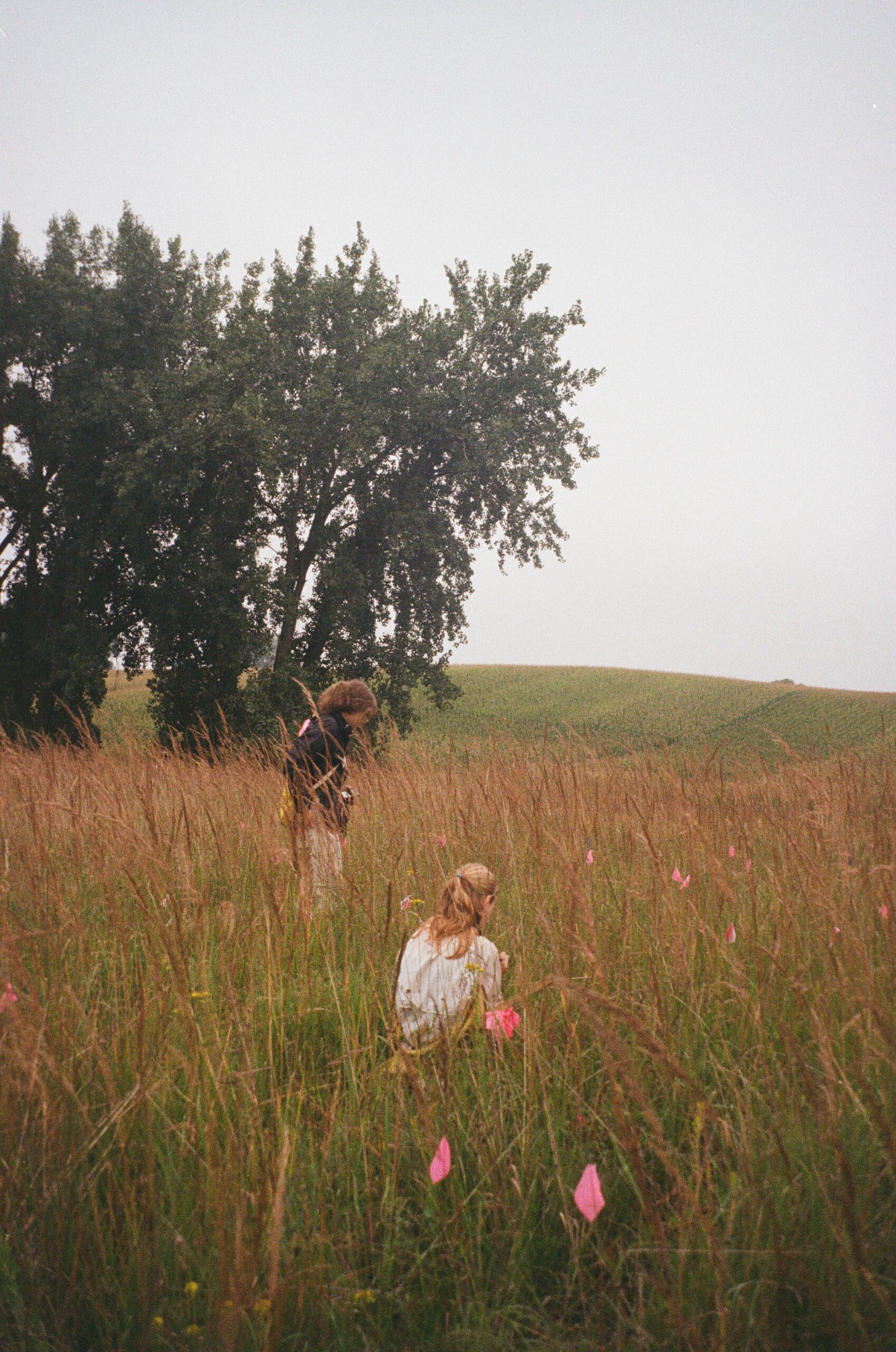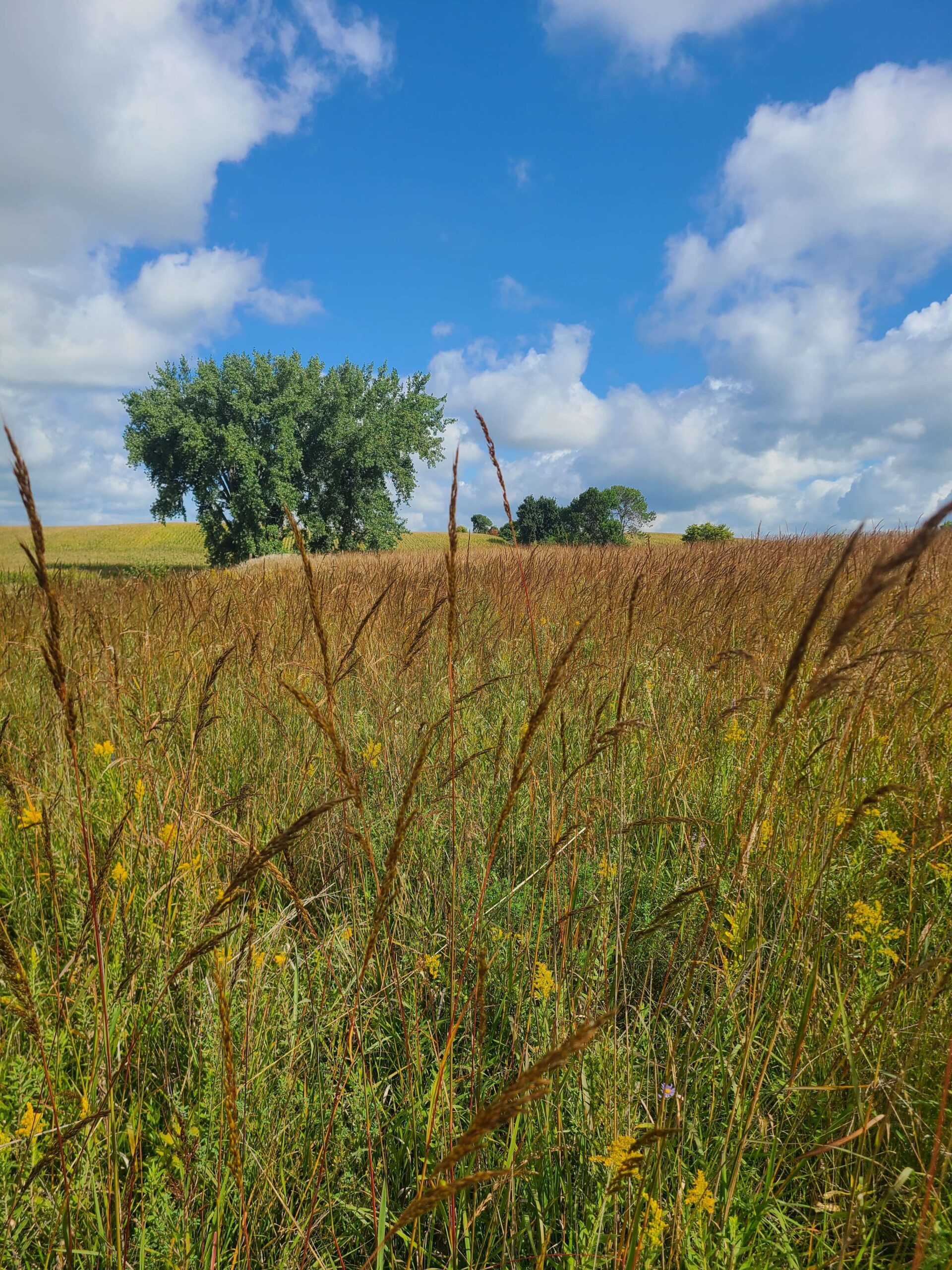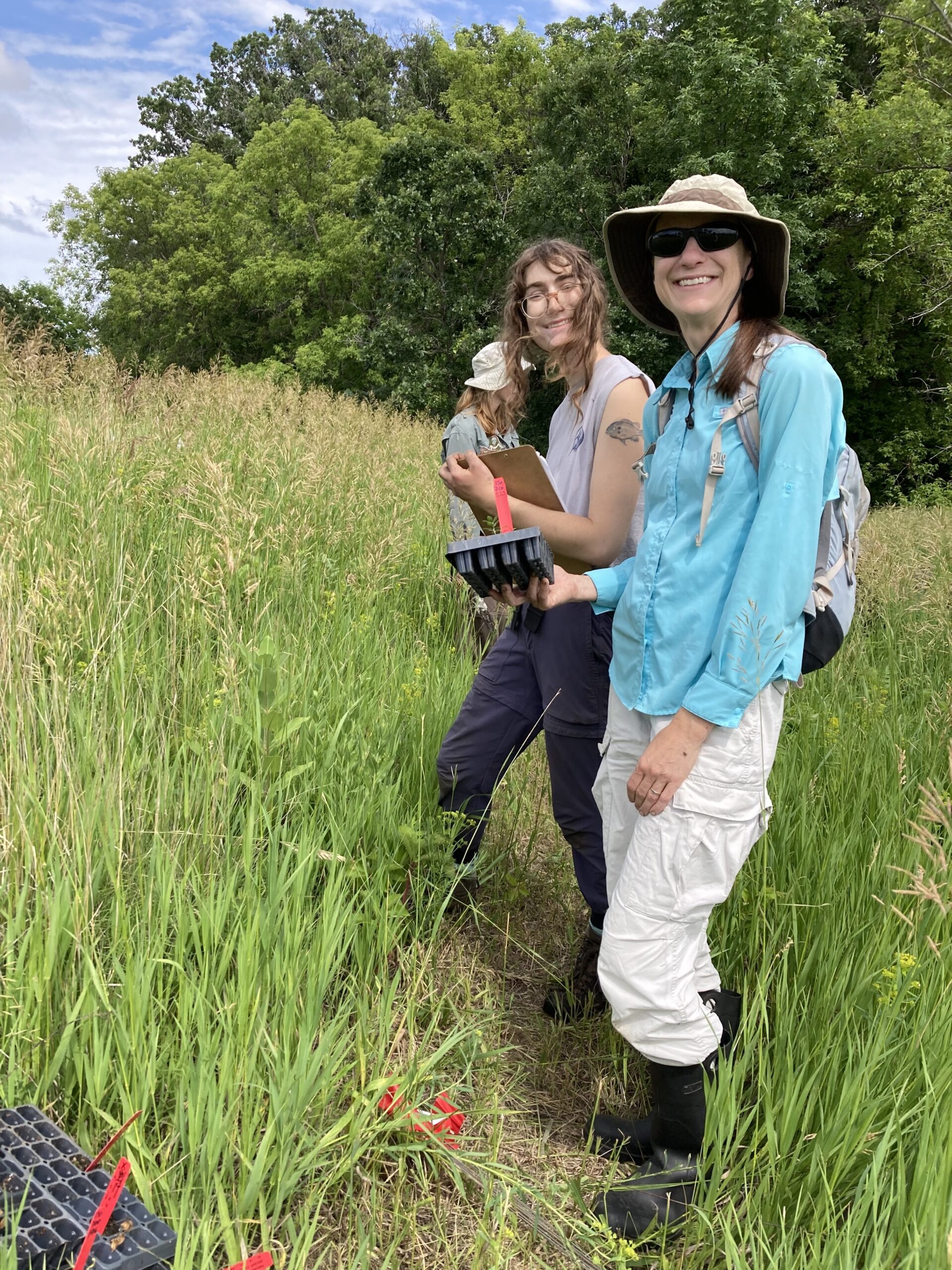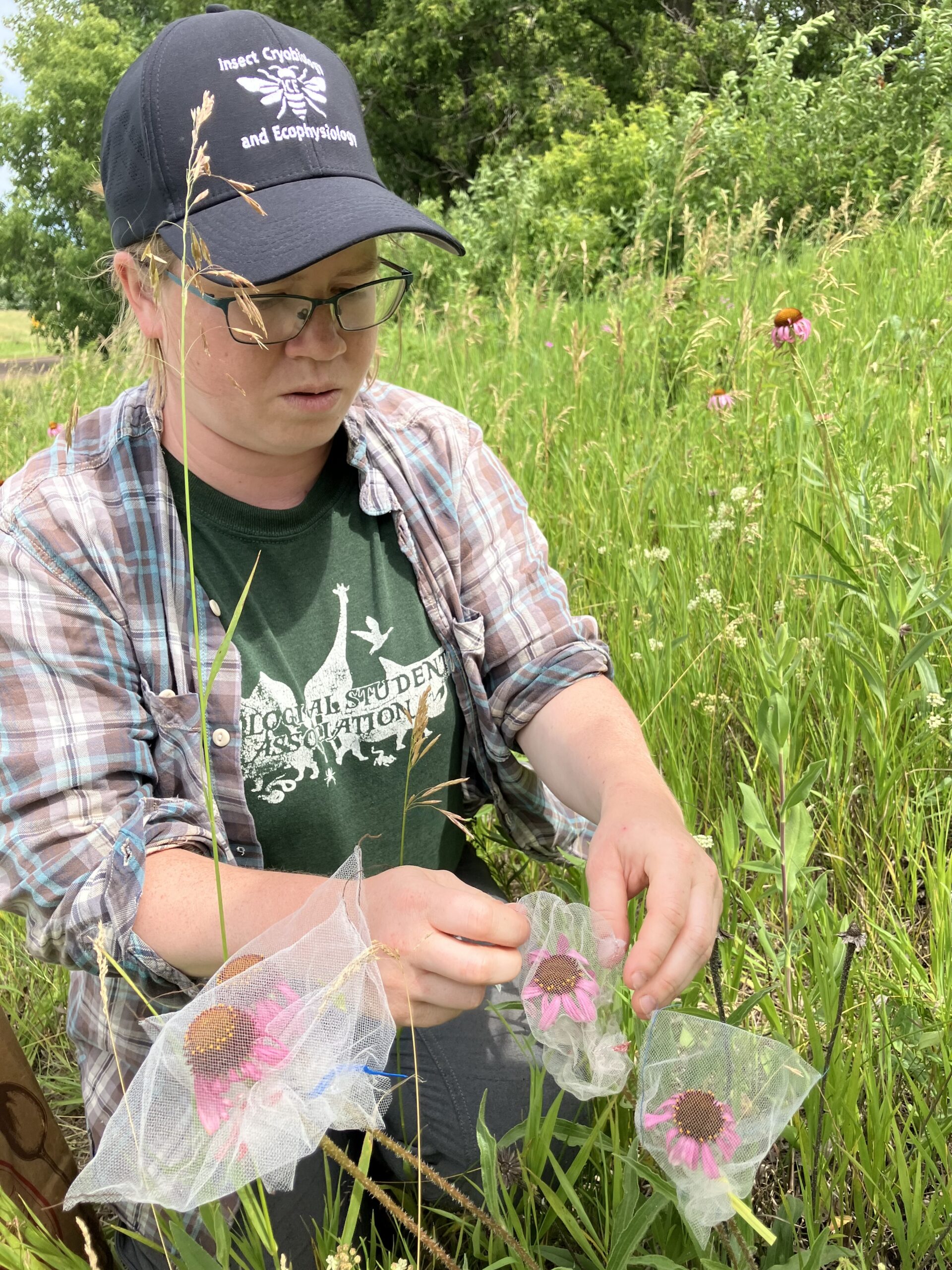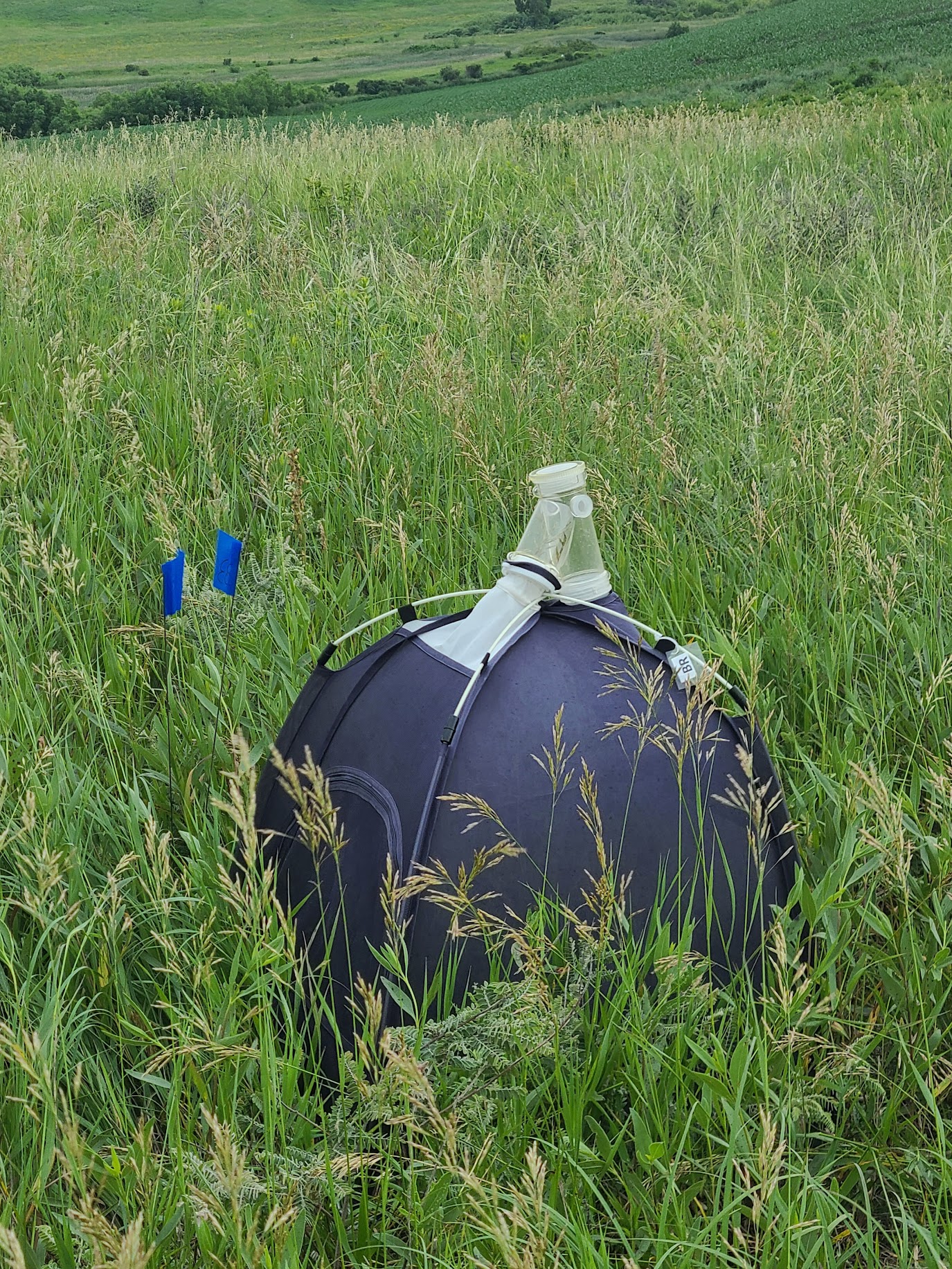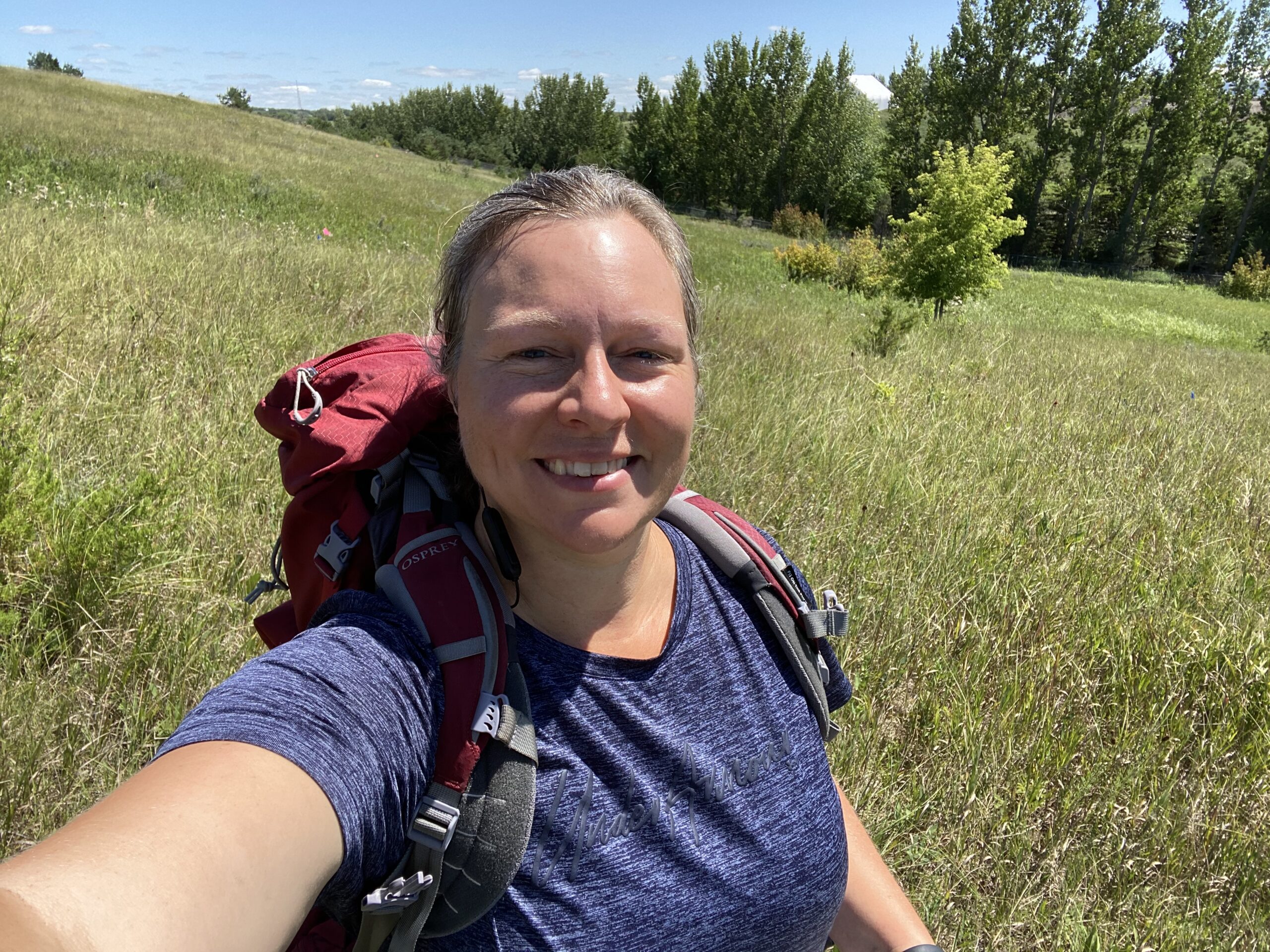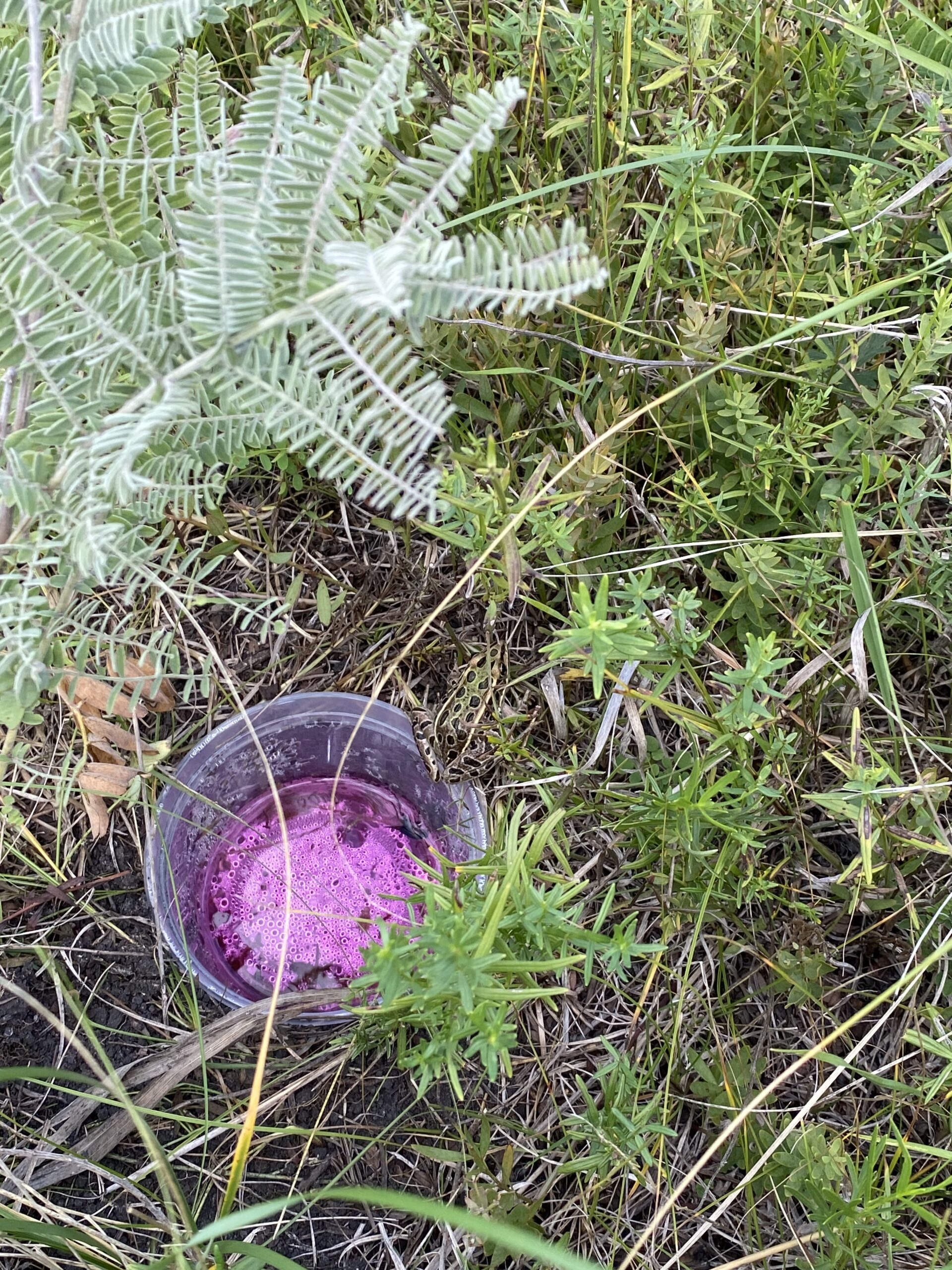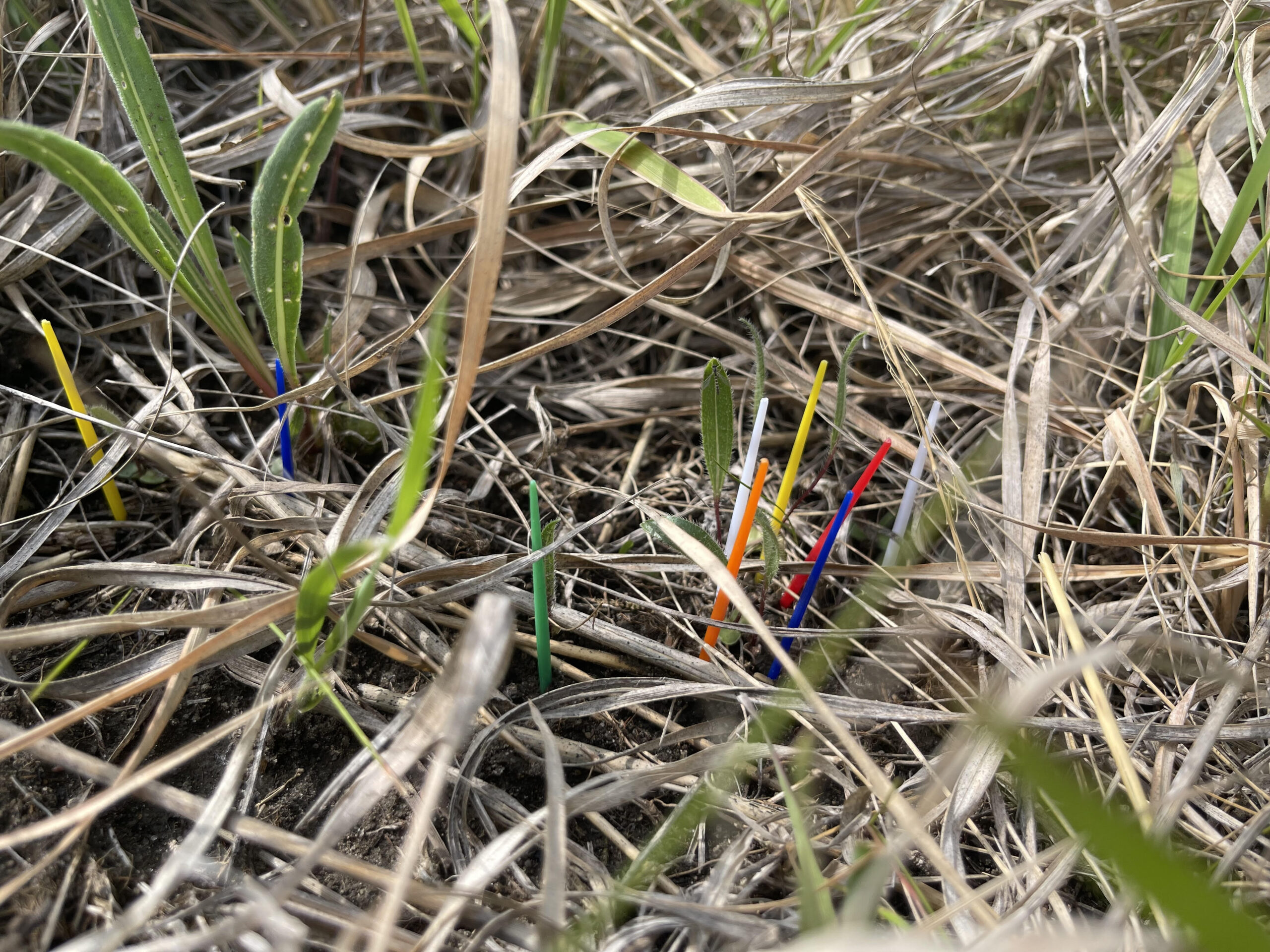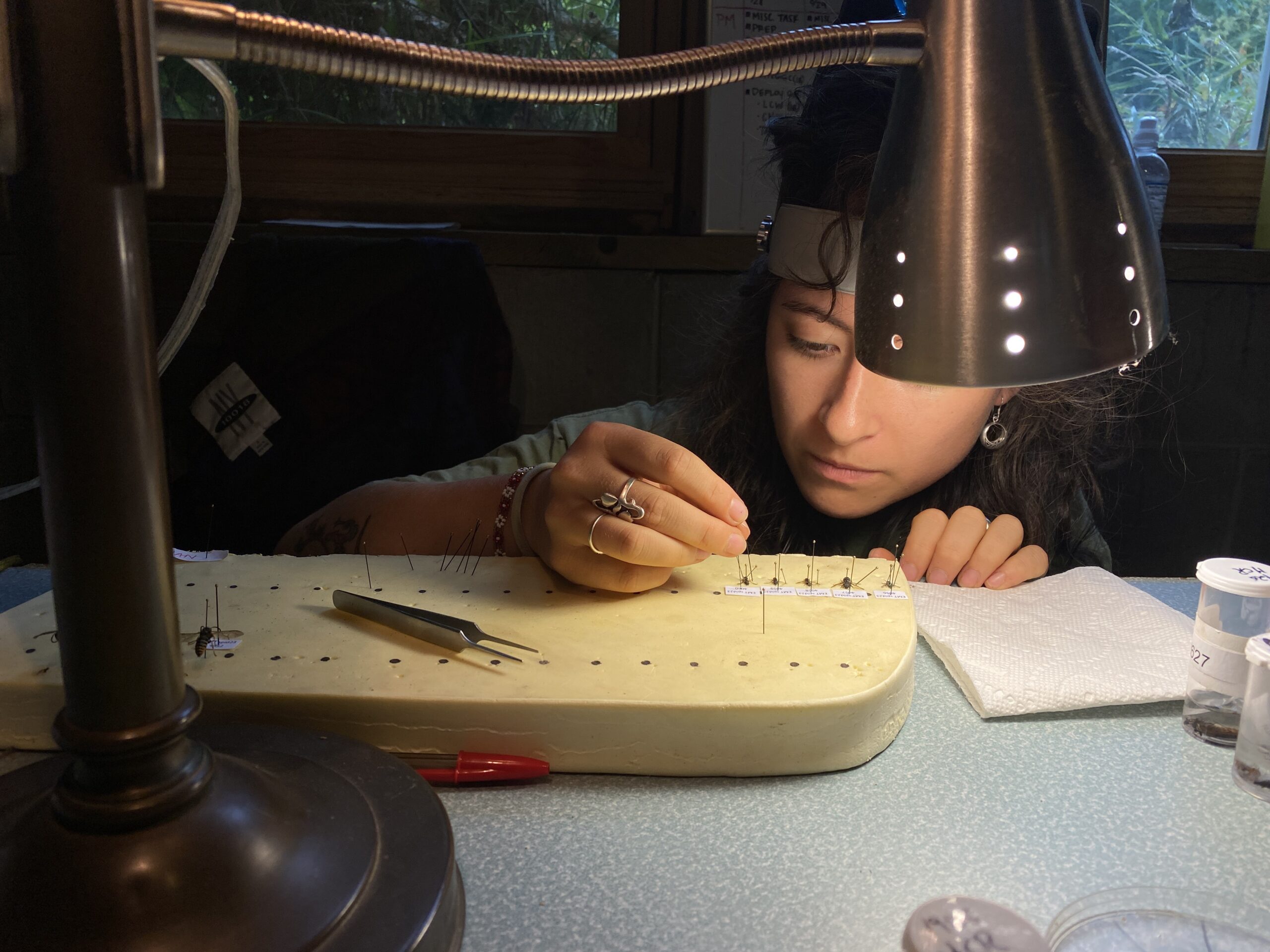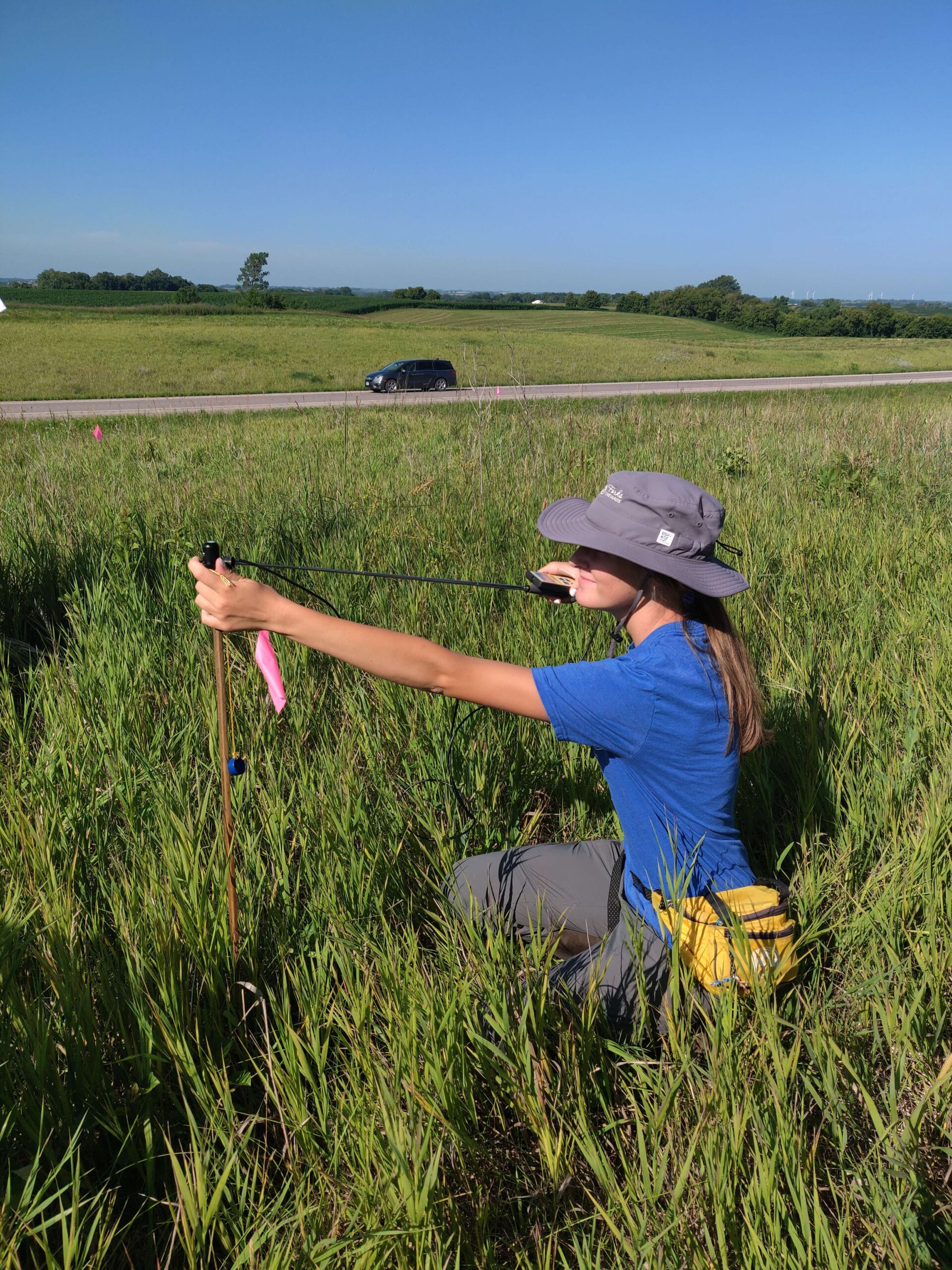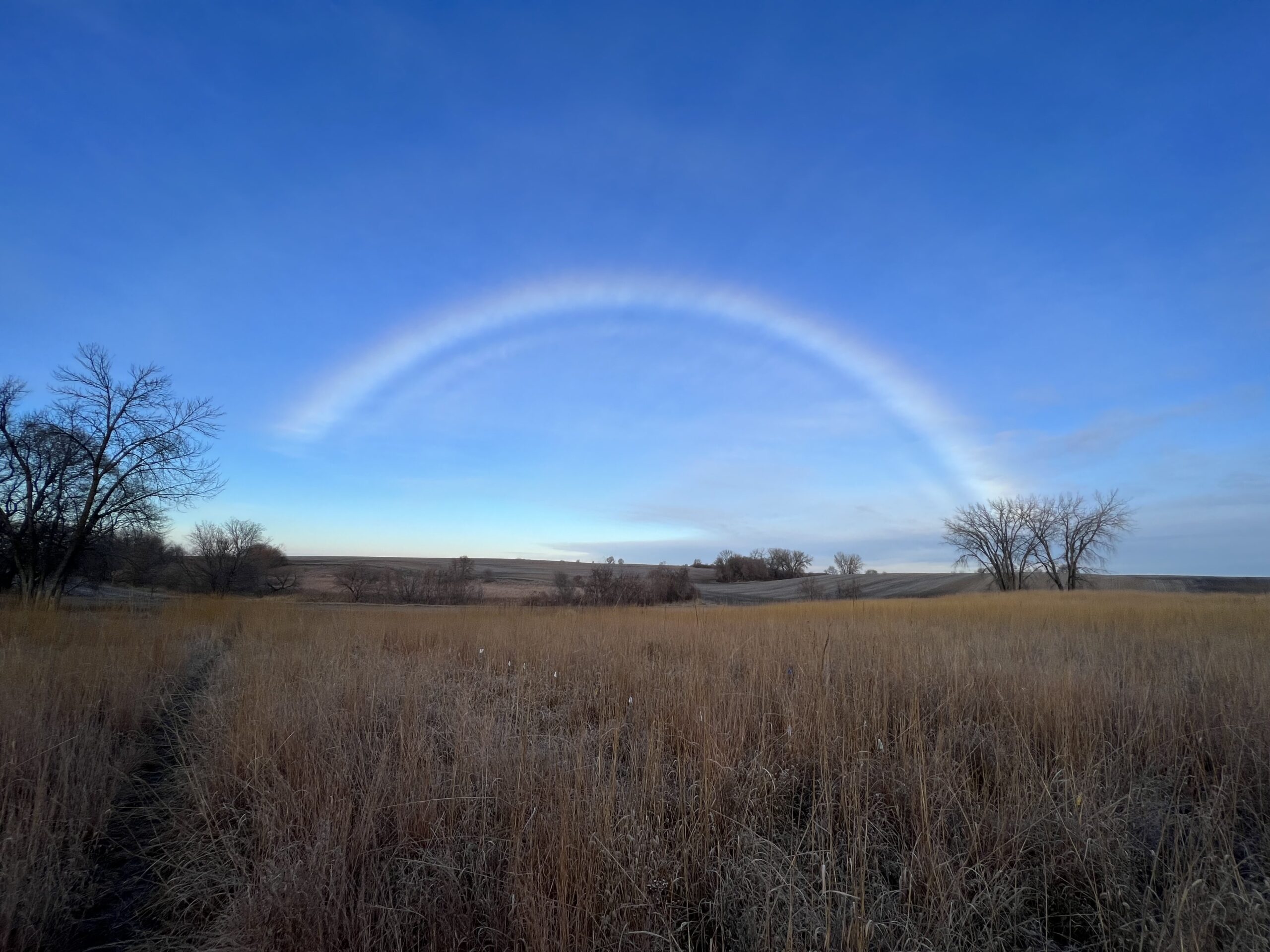
Introduction
Every year since 1996, members of Team Echinacea have recorded flowering phenology, taking measure data and harvested heads from thousands of Echinacea angustifolia plants in plots with “common garden” experimental designs. These experimental plots are located in prairie remnants, restorations, and abandoned agricultural fields that are managed as grassland habitat. Currently, the Echinacea Project has 10 established experimental plots. Some plots have multiple ongoing experiments within.
This project status report will contain updates on experimental plots 1, 2, 4, 5 and 8, as well as management updates for all plots. you can find reports for the other experimental plots on separate posts including Amy Dykstra’s plot (exPt03: interpopulation crosses and local adaptation experiment), the hybrid plots (exPt06, exPt07, exPt09), and the West Central Area common garden (exPt10)
A brief note on phenology
In the past few years, we have scaled back significantly on taking phenology records in the experimental plots. During 2023 and 2024, our primary goals with phenology were to a) map out the positions of flowering plants/heads within the plots, b) deploy twist ties to all flowering heads to ease measuring and harvesting, and c) to record the day of first flowering for all heads in plots to continue the long-term data collection in a more scaled-back fashion. As a result, we conducted only a few rounds of phenology per plot and did not capture the full range of flowering dates for every head. Phenology info is briefly reported on in each plot’s update along with the location of the data. This applies to the hybrid experimental plots as well.
exPt01:
Experimental plot 1 was first planted in 1996 (cleverly termed the 1996 cohort), and has been planted with nine other experiments in subsequent years, with the most recent planting being Amy Waananen’s inter-remnant crosses. It is the largest of the experimental plots, with over 10,000 planted positions; experiments in the plot include testing fitness differences between remnants (1996, 1997, 1999), quantifying effects of inbreeding (inb1, inb2), and assessing quantitative genetic variation (qGen1). It also houses a number of smaller experiments, including fitness of Hesperostipa spartea, aphid addition and exclusion, and pollen addition and exclusion (these experiments have separate posts).
In 2024, we conducted phenology in this plot between July 8th and July 18th. During measure, we visited 3123 of the 10,992 positions planted and found 2728 living plants. 83 plants were classified as “flowering” in exPt01 this year, totally 96 heads. This is a significantly fewer plants than flowered in summer 2023 (560). In summer 2024, we harvested 82 total Echinacea heads in exPt01 (including many from the ever-productive 99 south garden).
ExPt01 is also the only plot to have staples marking positions where plants that have died used to be. We added 67 staples to the experimental plot this year, but only in locations that we couldn’t find staples during measure that were already supposed to be there. We didn’t have time to get to every position with a missing staple (see where we covered here: Dropbox/CGData/125_measure/measure2024/staple2024/2024addStaplesExPt01.pdf). We did not have time to re-search locations that we called plants “can’t finds” at three years in a row in 2023 and 2024. Once these locations receive their final search, hopefully in 2025, we can put staples at them as well.
2024 exPt01 plant status overview
expNm yearPlanted nPlanted nFound nFlowering nCantFind
1 1996 1996 650 196 16 24
2 1997 1997 600 128 0 20
3 1998 1998 375 17 1 2
4 1999 1999 888 305 0 34
5 1999S 1999 418 250 21 18
6 2001 2001 350 30 4 8
7 Inbreeding 2001 557 73 4 24
8 SPP 2001 797 117 2 16
9 Monica 2003 2003 100 3 1 1
10 qGen 2003 4468 1328 28 212
11 INB2 2006 1470 281 6 34
12 Amy's Annex 2020 319 63 0 256That’s a total of 10,903 individuals planted in this plot! We found evidence of 2,791 living in 2024, 25.6% of the original number planted.
A number of the experiments in exPt01 are known by multiple names/abbreviations. Here’s a quick translation guide:
- 1996-1999 = p01 main
- SPP = Phoenix Trial in exPt01
- Monica 2003 = M03
- qGen = qGen1 = quantitative genetics = big batch = bbMost
- Amy’s annex = interremnant crosses
More details on some of the experiments within exPt01
Amy’s annex (aka interremnant crosses)
This experiment was started in 2020 by Amy Waananen to understand how the distance between plants in space and in their timing of flowering influences the fitness of their offspring. If plants that are located close together or flower at the same time are closely related, their offspring might be more closely related and inbred, and have lower fitness than plants that are far apart and/or flower more asynchronously. Plants in this experiment resulted from interremnant hand-crossings from 9 remnants: On27, SGC, GC, NGC, EELR, KJ, NNWLF, NWLF, LF. Crossing took place in 2020 and 2021, and individuals were planted in 2020 (as seed) and 2022 (as plugs). Surviving plants were assigned cgPlaIds in 2023 and incorporated into the p1 workflow. Mortality in this experiment has been high, with 80.3% of positions searched in 2024 resulting in “can’t finds.”. We did not re-search “can’t find” positions in 2024 due to time constraints (with Amy’s approval).
inb1
The inb1 experiment investigates the relationship between inbreeding level and fitness in Echinacea angustifolia. Each plant in experiment inb1 originates from one of three cross types, depending on the relatedness of the parents: between maternal half siblings; between plants from the same remnant, but not sharing a maternal or paternal parent; and between individuals from different remnants. All individuals were planted in 2001. We continued to measure fitness and flowering phenology in these plants.
inb2
The inb2 experiment investigates the relationship between inbreeding level and fitness in Echinacea angustifolia. Each plant in experiment inb2 originates from one of three cross types, depending on the relatedness of the parents: between maternal half siblings; between plants from the same remnant, but not sharing a maternal or paternal parent; and between individuals from different remnants. All individuals were planted in 2006. We continued to measure fitness and flowering phenology in these plants. In October 2024, former team member Riley Thoen recently published a paper in the Journal of Hereditary on the conservation value of small remnants using results from this experiment.
qGen1
The qGen1 (quantitative genetics, or just qGen) experiment in p1 was designed to quantify the heritability of traits in Echinacea angustifolia. We are especially interested in Darwinian fitness. Could fitness be heritable? During the summer of 2002 we crossed plants from the 1996 & 1997 cohorts of exPt01. We harvested heads, dissected achenes, and germinated seeds over the winter. In the spring of 2003 we planted the resulting 4468 seedlings (this great number gave rise to this experiment’s nickname “big batch”).
- Start year: 1996
- Location: Wagenius property
- Overlaps with:
- Data collected:
- Phenology data (dates of flowering stages)
- data in cgData repo:
~/cgData/summer2024/exPt01Phenology
- data in cgData repo:
- Measure data (status, size, etc.)
- data in SQL database
- Harvest data (IDs of harvested heads, missing achenes, etc)
- detailed data in dropbox:
dropbox/CGData/140_reconcile/reconcile2024/reconcileOut/2024harvestListReconciledExport.csv - data in SQL database
- data in echinaceaLab package (hh.2024)
- detailed data in dropbox:
- Phenology data (dates of flowering stages)
- Samples collected:
- 82 heads harvested
- At cbg for processing (counted, ready to randomize)
- 82 heads harvested
- Products:
- Publications
- Thoen, R. D., A. Southgate, G. Kiefer, R.G. Shaw, S. Wagenius, The conservation value of small population remnants: Variability in inbreeding depression and heterosis of a perennial herb, the narrow-leaved purple coneflower (Echinacea angustifolia). 2024. Journal of Heredity esae055. https://doi.org/10.1093/jhered/esae055.
- Page, M. L., Ison, J. L., Bewley, A. L., Holsinger, K. M., Kaul, A. D., Koch, K. E., Kolis, K. M., and Wagenius, S. 2019. Pollinator effectiveness in a composite: A specialist bee pollinates more florets but does not move pollen farther than other visitors. American Journal of Botany 106: 1487–1498. PDF
- Waananen, A., G. Kiefer, J. L. Ison, and S. Wagenius. 2018. Mating opportunity increases with synchrony of flowering among years more than synchrony within years in a nonmasting perennial. The American Naturalist 192: 379-388. PDF | Appendix | online version
- Muller, K. and S. Wagenius. 2016. Echinacea angustifolia and its specialist ant-tended aphid: a multi-year study of manipulated and naturally-occurring aphid infestation. Ecological Entomology 41: 51-60. PDF | online version
- Shaw, R. G., S. Wagenius and C. J. Geyer. 2015. The susceptibility of Echinacea angustifolia to a specialist aphid: eco-evolutionary perspective on genotypic variation and demographic consequences. Journal of Ecology 103: 809-818. PDF
- Kittelson, P., S. Wagenius, R. Nielsen, S. Qazi, M. Howe, G. Kiefer, and R. G. Shaw. 2015. Leaf functional traits, herbivory, and genetic diversity in Echinacea: Implications for fragmented populations. Ecology 96: 1877–1886. PDF
- Ison, J.L., and S. Wagenius. 2014. Both flowering time and spatial isolation affect reproduction in Echinacea angustifolia. Journal of Ecology 102: 920–929. PDF | Supplemental Material | Archived Data
- Ison, J.L., S. Wagenius, D. Reitz., M.V. Ashley. 2014. Mating between Echinacea angustifolia (Asteraceae) individuals increases with their flowering synchrony and spatial proximity. American Journal of Botany 101: 180-189. PDF
- Ridley CE, Hangelbroek HH, Wagenius S, Stanton-Geddes J, Shaw RG, 2011. The effect of plant inbreeding and stoichiometry on interactions with herbivores in nature: Echinacea angustifolia and its specialist aphid. PLoS ONE 6(9): e24762. http://dx.plos.org/10.1371/journal.pone.0024762
- Wagenius, S., H. H. Hangelbroek, C. E. Ridley, and R. G. Shaw. 2010. Biparental inbreeding and interremnant mating in a perennial prairie plant: fitness consequences for progeny in their first eight years. Evolution 64: 761-771. Abstract | PDF
- Ruth G. Shaw, Charles J. Geyer, Stuart Wagenius, Helen H. Hangelbroek, and Julie R. Etterson. 2008. Unifying life-history analyses for inference of fitness and population growth. American Naturalist 172: E35 – E47. Abstract | PDF | Supplemental Material
- Geyer, C.J., S. Wagenius, and R.G. Shaw. 2007. Aster models for life history analysis. Biometrika 94: 415-426. PDF | Supplemental Material
- Grad student work
- Drake Mullett’s PhD dissertation (2025)
- Wyatt Mosiman’s MS thesis (2024)
- Amy Waananen’s paper “The fitness effects of outcrossing distance depend on parental flowering phenology in fragmented populations of a tallgrass prairie forb” (with co-authors Ison, Wagenius, and Shaw) was just accepted by New Phytologist–it includes data from parents in exPt01 and progeny in exPt02.
- We may have missed some other products.
- Publications
exPt02:
AKA the heritability of flowering time experiment, exPt02 was designed to examine the role flowering phenology plays in the reproduction of Echinacea angustifolia. Jennifer Ison planted this plot in 2006 with 3,961 individuals selected for extreme (early or late) flowering timing, known as phenology. Using this phenological data, we explore how flowering phenology influences reproductive fitness and estimate the heritability of flowering time in E. angustifolia. In the summer of 2024, we conducted phenology between July 10th and July 19th. During measure, we visited 1,725 positions of the 3,961 positions originally planted. We measured 1,190 living plants, of which 302 were flowering with a total of 402 flowering heads (count excludes vertical developments). In the fall, we harvested 375 heads from exPt02. We observed much lower levels of seed predation by ground squirrels this year than the past few years.
- Start year: 2005 (crossing) and 2006 (planting)
- Location: Hegg Lake WMA (DNR)
- Overlaps with:
- common garden experiments, heritability of flowering time
- Data collected:
- Phenology data (dates of flowering stages)
- data in cgData repo:
~/cgData/summer2024/exPt02Phenology
- data in cgData repo:
- Measure data (status, size, etc.)
- data in SQL database
- Harvest data (IDs of harvested heads, missing achenes, etc)
- detailed data in dropbox:
dropbox/CGData/140_reconcile/reconcile2024/reconcileOut/2024harvestListReconciledExport.csv - data in SQL database
- data in echinaceaLab package (hh.2024)
- detailed data in dropbox:
- Phenology data (dates of flowering stages)
- Samples collected:
- 375 heads harvested
- at CBG for processing
- 375 heads harvested
- Products:
- Papers
- Pearson, A.E., Z. Zelman, L.A. Hill, M.A. Stevens, E.X. Jackson, M.M.N. Incarnato, R.M. Johnson, S. Wagenius, and J.L. Ison. 2023. Pollinators differ in their contribution to the male fitness of a self-incompatible composite. American Journal of Botany 110(6): e16190. https://doi.org/10.1002/ajb2.16190
- Reed, W. J., J. L. Ison, A. Waananen, F. H. Shaw, S. Wagenius, R. G. Shaw. 2022. Genetic variation in reproductive timing in a long-lived herbaceous perennial. American Journal of Botany 109(11) 1861–1874: https://doi.org/10.1002/ajb2.16072
- Page, M. L., Ison, J. L., Bewley, A. L., Holsinger, K. M., Kaul, A. D., Koch, K. E., Kolis, K. M., and Wagenius, S. 2019. Pollinator effectiveness in a composite: A specialist bee pollinates more florets but does not move pollen farther than other visitors. American Journal of Botany 106: 1487–1498. PDF
- Grad student work
- Wyatt Mosiman’s MS thesis (2024)
- Amy Waananen’s paper “The fitness effects of outcrossing distance depend on parental flowering phenology in fragmented populations of a tallgrass prairie forb” (with co-authors Ison, Wagenius, and Shaw) was just accepted by New Phytologist–it includes data from parents in exPt01 and progeny in exPt02.
- We may have missed some other products.
- Papers
exPt05:
The only experimental plot at Staffanson Prairie Preserve (SPP), exPt05 was planted to compare progeny of maternal plants from burned and unburned sections of SPP. There were originally 2800 individuals planted, but high mortality made it impractical to visit the plot row-by-row. Now, we treat the plot like demography. We use our survey-grade GPS to find plants in exPt05 that have previously flowered and add more plants to the stake file if new plants in the plot flower. In 2024, we found 17 living plants in exPt05 during flowering/total demo, 8 of which were flowering! We also observed (but did not take data on) additional basal plants within the plot boundaries that appeared to be growing on a 1×1 meter grid. ExPt05 persists!
- Start year: 2011
- Location: Staffanson Prairie Preserve (TNC)
- Overlaps with:
- Data collected:
- Demography data: head counts, rosette counts, etc.
- demap input files have been updated with 2024
- Spatial location for all flowering and some basal plants
- demap input files have been updated with 2024
- Harvest data (IDs of harvested heads, missing achenes, etc)
- detailed data in dropbox:
dropbox/CGData/140_reconcile/reconcile2024/reconcileOut/2024harvestListReconciledExport.csv - data in echinaceaLab package (hh.2024)
- detailed data in dropbox:
- Demography data: head counts, rosette counts, etc.
- Samples collected:
- None (we did not harvest heads in exPt05 this year)
- Products:
- None… yet!
exPt08:
qGen2/qGen3
Team Echinacea established quantitative genetics experiments to quantify additive genetic variance of fitness in Echinacea, with the idea that we can estimate evolutionary potential of study populations. The plants in qGen2 and qGen3 are plants in the 1996, 1997, and 1999 cohorts. These plants were crossed with pollen from plants in remnants to produce seed for qGen2 and qGen3, which now inhabit exPt08. Originally, 12,813 seeds were sown in the common garden. Seeds from the same cross (shared maternal and paternal plants) were sown in meter-long segments between nails. In the summer of 2024, we conducted phenology between July 10th and July 19th. A total of 3,253 seedlings were originally found, but due to gradual mortality we only searched 448 positions in 2024 for plants, and we found evidence of 314 living individuals. We identified 24 flowering plants in with a total of 29 heads, of which we harvested 23.
- Start year: 2013 (qGen2) and 2015 (qGen3)
- Location: exPt08 (Wagenius property)
- Overlaps with:
- Data collected:
- Phenology data (dates of flowering stages)
- data in cgData repo:
~/cgData/summer2024/exPt08Phenology
- data in cgData repo:
- Measure data (status, size, etc.)
- data in SQL database
- Harvest data (IDs of harvested heads, missing achenes, etc)
- detailed data in dropbox:
dropbox/CGData/140_reconcile/reconcile2024/reconcileOut/2024harvestListReconciledExport.csv - data in SQL database
- data in echinaceaLab package (hh.2024)
- detailed data in dropbox:
- Phenology data (dates of flowering stages)
- Samples collected:
- 23 heads harvested
- at CBG for processing
- 23 heads harvested
- Products:
- None… yet!
tplot
tplot is located within the bounds of exPt08. Plants of many species here were rescued from the landfill site. They we transferred as chunks of prairie sod, and individual transplants. This year during flowering and total demo, we encountered 14 living Echinacea plants from which we harvest 12 heads.
- Start year: 1994 or 1995
- Location: exPt08 (Wagenius property)
- Overlaps with:
- Data collected:
- Demography data: head counts, rosette counts, etc.
- demap input files have been updated with 2024
- Spatial location for all flowering and some basal (total demo) plants
- demap input files have been updated with 2024
- Harvest data (IDs of harvested heads, missing achenes, etc)
- detailed data in dropbox:
dropbox/CGData/140_reconcile/reconcile2024/reconcileOut/2024harvestListReconciledExport.csv - data in echinaceaLab package (hh.2024)
- detailed data in dropbox:
- Demography data: head counts, rosette counts, etc.
- Samples collected:
- 12 heads harvested
- at CBG for processing
- 12 heads harvested
- Products:
- None… yet!
Experimental plot management:
Just like other areas of the prairie, our experimental plots need management! Here’s a list of the stewardship activities that we conducted in or for our plots during 2024:
- None of our experimental plots burned in the fall or spring prior to the 2024 growing season
- Mapped and removed hawkweed in exPt01
- Removed sweet clover in exPt01
- Removed poison ivy in exPt02
- Harvested tall grasses (i.e., Andropogon gerardii & Sorghastrum nutans)
- Collected seed to plant in p1, p2, & p8, including:
- 1) Elise collected Carex brevior, Carex bicknellii, and Carex gravida from several sites and from plants that we established a few years ago near exPt01
- 2) Liam established Viola pedatifida production tub,
- 3) We collected a few additional species (including Galium boreale, Solidago missouriensis, Astragalus adsurgens, Dichanthelium leibergii, and Bromus kalmii) we plan to establish via plug in spring 2025
Psst – next year person writing this report; I ran my numbers using the script Dropbox/echProjAdmin/projectStatusReports/psr2024/wmGatherDataForReports2024.R. Maybe this can help you out.

